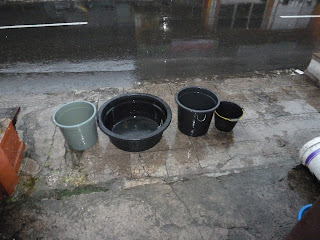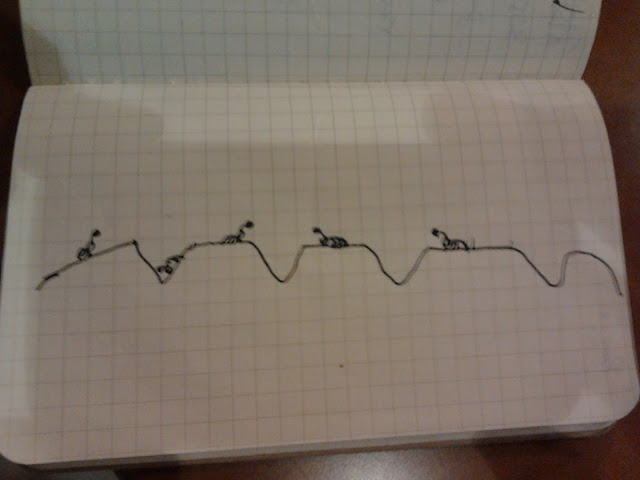It was a dark and stormy night. The small room was atwitter with the pitter pitter of rain falling on metal, the drops coalescing into rivulets in the ridges of the corrugated tin roof. Steady streams of water flowed from the gently sloping roof into the buckets beneath, arrayed strategically to capture the maximum amount of fluid from the ephemeral cloudburst. The residents of 13 Pemuda street, dwelling there for differing degrees of temporariness, smiled; the next day they would be able to bathe and flush the toilet.
The Water Crisis
For the past three months water has been a problem at my temporary residence, the home of my good friend Agung. The crisis started due to the unusual dryness of the dry season. A general lack of even the most minute amounts of precipitation affected Sungai Penuh and the entire Kerinci Valley region. By the end of the holy month of Ramadan, Pemuda street was being served daily by a water truck, which made deliveries which were then carried by residents in buckets into their respective homes.
 |
| The improvised tap |
A couple of weeks ago water was restored, but for some reason none made it into the pipes supplying the houses on the north side of the street (including Agung's). Since the truck was no longer coming daily, this posed a significant problem for half the street. Repeated complaints to the water board went unheeded and the problem was only solved when one unidentified resident uncovered the feeder pipe to the south side houses and grafted in a tap. Soon a system of turn-taking arose among the residents of the north side, who daily filled buckets at the improvised tap.
Everything was going fine for several weeks until two days ago. I was sitting on the curb waiting for our buckets to fill (usually a half-hour operation), reading patiently when two gentlemen pulled up on a motor-bebek. I soon learned that they were from the water board. Evidently site of one of the four foreigners in the region filling buckets from an unauthorized, and more importantly unmetered tap had drawn the attention of the authorities. Soon they learned from other residents what was going on.
"You
Everything was going fine for several weeks until two days ago. I was sitting on the curb waiting for our buckets to fill (usually a half-hour operation), reading patiently when two gentlemen pulled up on a motor-bebek. I soon learned that they were from the water board. Evidently site of one of the four foreigners in the region filling buckets from an unauthorized, and more importantly unmetered tap had drawn the attention of the authorities. Soon they learned from other residents what was going on.
"You
 |
| Adding a tap. The helmet is obviously for safety. |
shouldn't take water from that tap", one of the men said to me. "It's stealing".
"I see. Do you have a word in Indonesian for when a public utility refuses to respond to customer complaints arising from said utility's failure to provide for a basic human need for 3 months?" I responded.
"Hmmmmmm....." said the water man, walking away.
The watermen immediately went to work. Somehow within 15 minutes water was restored to the main pipe (1) feeding the north side of the street, but with insufficient pressure to pump the water up the one meter required to make it into our bak mandi (2). They then installed a plastic tap outside the front door at ground level just past our water meter so we could fill buckets and then empty them into the bak mandi. They achieved this with a can of wet-dry cement and a hacksaw blade (only the blade). Then they went to work on the improvised tap. They had a length of polybutylene pipe they were going to use to rejoin the line sans the tap. One of the men asked us for some old newspapers. In a feat of ingenuity that puts my tightfisted old Highland landlord to shame, he used the newspapers to build a fire on the sidewalk and used it to heat the plastic pipe so it could be bent to the required angle to fit the line (3). Then they went on their merry way.
"I see. Do you have a word in Indonesian for when a public utility refuses to respond to customer complaints arising from said utility's failure to provide for a basic human need for 3 months?" I responded.
"Hmmmmmm....." said the water man, walking away.
The watermen immediately went to work. Somehow within 15 minutes water was restored to the main pipe (1) feeding the north side of the street, but with insufficient pressure to pump the water up the one meter required to make it into our bak mandi (2). They then installed a plastic tap outside the front door at ground level just past our water meter so we could fill buckets and then empty them into the bak mandi. They achieved this with a can of wet-dry cement and a hacksaw blade (only the blade). Then they went to work on the improvised tap. They had a length of polybutylene pipe they were going to use to rejoin the line sans the tap. One of the men asked us for some old newspapers. In a feat of ingenuity that puts my tightfisted old Highland landlord to shame, he used the newspapers to build a fire on the sidewalk and used it to heat the plastic pipe so it could be bent to the required angle to fit the line (3). Then they went on their merry way.
 |
| Yours truly and the 3-bucket system |
Now Agung and I are served by a thin trickle of water from about 10am to 12pm every day. During this time we connect a hose to the tap and collect buckets of water to fill the bak mandi and an additional storage tub. We've devised a three bucket system with a syphon, but it still takes about two hours due to the rate at which the water flows. During this time I read and dream of archimedes screws and ram pumps, and realize that my knowledge of pre-industrial hydraulic genius is lacking. When it rains fairly heavily we can collect 20 gallons or so in about an hour from the roof.
The Geography of Water
The whole water crisis has been an interesting experience for me, because I've always lived in areas where water was abundant. The two-hour-a-day has led me to think a bit about a resource that most people take for granted, though. The availability of water is really a geographic phenomenon; aside from the physical location of water, which in many cases helps determine what sorts of human activities will take place in a given location, availability of water also affects human potential in that the more time you spend looking for water, the less time you can devote to other activities. Clean, freely flowing water is a luxury in many parts of the world. The map below shows the percentage of the population in different parts of the world that have access to clean water. Can you notice any spatial trends?
 |
| Photo from Clean Water for the World |
In parts of Africa, where more than 300 million people lack access to clean water, it is unheard of. What's more, in many places the burden of collecting water falls unevenly on the backs of women. In some parts of Africa, women walk up to ten miles daily in search of water. In seasonal tropical climates this distance can double in the dry season, when ephemeral streams dry up. According to Water Aid, the journey is often rife with danger, and the source of water is often polluted. What's more, water containers are heavy, and along with the health problems associated with the dirty water many women suffer back problems from hauling the water over such distances.
The provision of clean water is, in theory at least, a global priority. Access to safe water is part of several of the much-publicized Millennium Development Goals, including those involving improving sanitation and ending hunger. Numerous NGOs and multilateral organizations have programs to improve access to water, but there is still a lot to be done. Below I've included some facts about water from various sources.
- 400 million children (one in five in the developing world) has no access to safe water (UNICEF)
- Unsafe water and sanitation cause about 4,000 child deaths per day (UNICEF)
- 80% of all sickness is tied to lack of access to safe water (WHO)
- 2.1 million people per year die of diarrhoeal diseases, 88% of these are linked to unsafe water (WHO)
Picture of the day...
 |
| From HippoRoller site |
I shamelessly lifted today's picture from the internet. I came across it when I was looking for facts and maps about water. The HippoRoller is a neat invention that promises to ease the burden of transporting water long distances and possibly alleviate some of the health problems stemming from hauling water long distances.
Notes
1. The "main" pipe is 1/2 pvc
2. The bak mandi is a stone or concrete reservoir found in the bathroom in Indonesian residences and businesses. You draw water with a dipper from the bak mandi to manually "flush" the squat toilet and wash your hands.
3. I will never forget this trick and have a strong sense that it will someday come in handy.
For Further Reading:
1. The "main" pipe is 1/2 pvc
2. The bak mandi is a stone or concrete reservoir found in the bathroom in Indonesian residences and businesses. You draw water with a dipper from the bak mandi to manually "flush" the squat toilet and wash your hands.
3. I will never forget this trick and have a strong sense that it will someday come in handy.
For Further Reading:
For a closer look at water crises around the world, check out this great graphic from the BBC.























